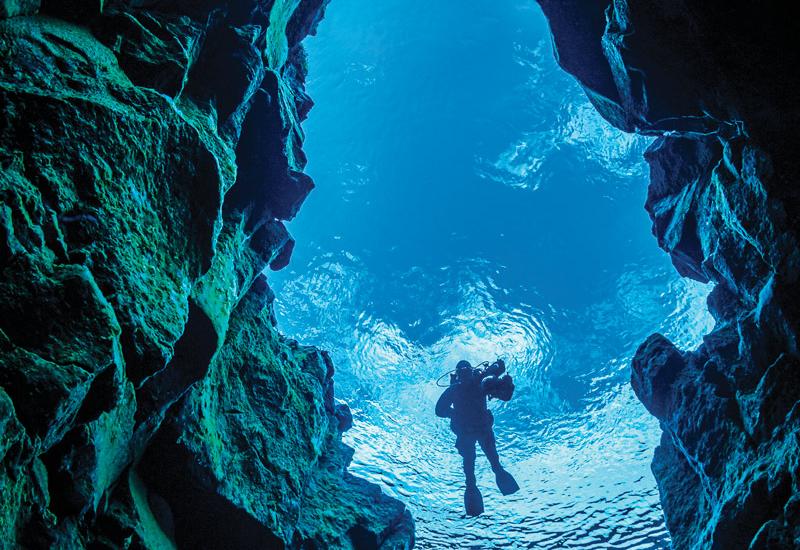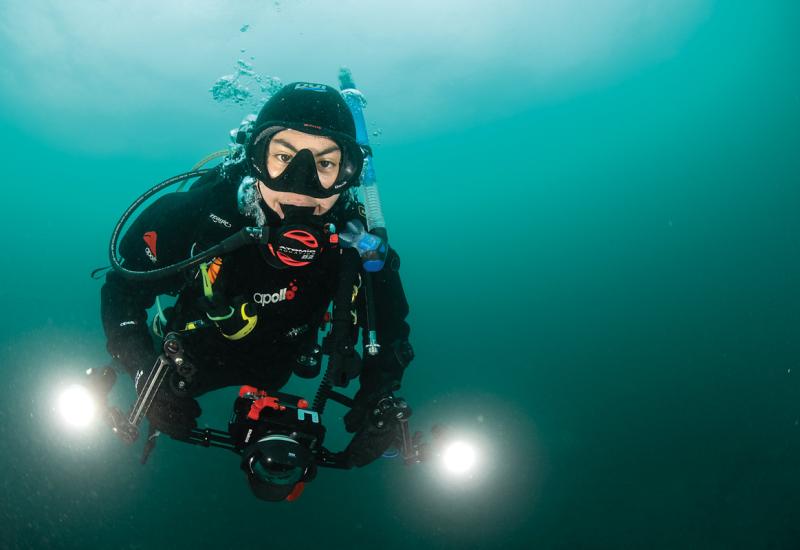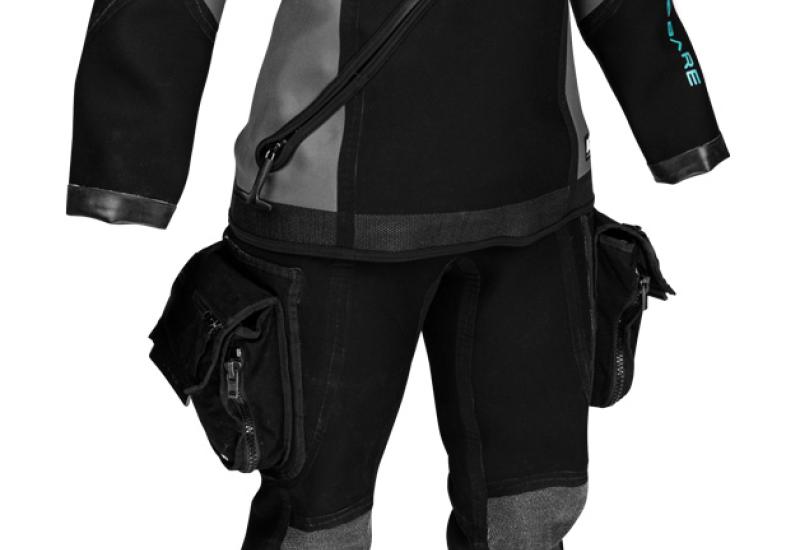ScubaLab Blog #2: Drysuit Tests 2011
Blog #2: Backstage at the Oregon Coast Aquarium
The day dawned cold and misty, with big waves pounding the gray, rain-swept sand. Forgive me if I overly romanticize my first impression of the Oregon coast, but that’s exactly what it looked like — and exactly how I’d always pictured it. However, the Oregon Coast Aquarium was the complete opposite of the aquariums I’m familiar with. Over the past 11 years, my experience with sea creatures in captivity has been primarily with the hugely commercialized and criminally cetacean-centric Florida attractions. But not so with the Oregon Coast Aquarium (OCAq). The OCAq was the home of the Keiko/Free Willy rehabilitation facility, constructed in 1995, to reintroduce the famous killer whale to the wild, not to force him to perform for an audience. In fact, this magnificent aquarium has no captive cetaceans at all and showcases only indigenous Pacific Northwest fauna.
That morning, I met Val at the aquarium for a guided tour of the entire facility, which includes not just the aquatic exhibits that feature giant Pacific octopi, sea lions, seals, sea otters and the like, but swampland and rocky-shore habitats, as well as seabird and turkey-vulture aviaries. But the OCAq exhibit that would play host to ScubaLab would be “Passages of the Deep.” Here, OCAq visitors can stroll along a series of walkways that pass through the middle of the aquarium itself, enjoying 360 degrees of ecosystem viewing. Passages of the Deep allows visitors to literally immerse themselves in the Oregon coastal realm while staying dry, which is not entirely unlike what the ScubaLab Test Team planned to do. Passages of the Deep is quite large and actually includes three distinct habitats:
Orford Reef
Named after a location just off the Oregon Coast near Point Blanco, Orford Reef is a cluster of submerged haystack rock formations, only the tops of which are visible above water. Beneath, the areas between these rocks form a deep reef of narrow crevasses and swaying forests of bull kelp. Below the kelp forest, the reef provides a natural shelter from the weather and wave action, creating a stable refuge for a variety of species. The most predominant denizen of Orford Reef is the rockfish, of which there are 60 different species in the Pacific. These predatory fish hang suspended in still water or hide in the drifting kelp as they stalk their unsuspecting prey. The Orford Habitat is also home to the OCAq’s population of wolf eels.
Halibut Flats
There’s more sunlight in Halibut Flats than in the narrow canyons of Orford Reef, and therefore, the animals are more active. In ecosystems like this one, a tremendous number of interconnected species form a vibrant underwater community. Aside from the sturgeon, lingcod, flounder and the eponymous halibut that constantly patrol the habitat, the floor is a resting ground for skates, a disk-shaped species related to rays and sharks.
Open Sea
The longest tunnel in Passages of the Deep also represents the world’s largest environment — the Open Sea. Here there are no towering kelp forests or narrow rocky channels, just water as far as the eye can see. Most of the species represented in this exhibit live in the upper strata of the ocean, the Sunlit Zone. This area is alive with five species of shark, huge bat rays and great schools of anchovy and mackerel. The sharks, of course, are the star attraction, with all species native to Oregon coastal waters, including pelagic diva Miss Piggy, an 11-foot Broadnose Sevengill shark.
I was most eager to jump into the pelagic habitat, but Val suggested that I get my feet wet — or dry in this case — in the Halibut Flats habitat first. I was about to get back into diving dry, and in a thoroughly modern way.
Next Up: The drysuit testing begins
To read the other ScubaLab blog entries, click on the Related links below.

Cindy Hanson
Blog #2: Backstage at the Oregon Coast Aquarium
The day dawned cold and misty, with big waves pounding the gray, rain-swept sand. Forgive me if I overly romanticize my first impression of the Oregon coast, but that’s exactly what it looked like — and exactly how I’d always pictured it. However, the Oregon Coast Aquarium was the complete opposite of the aquariums I’m familiar with. Over the past 11 years, my experience with sea creatures in captivity has been primarily with the hugely commercialized and criminally cetacean-centric Florida attractions. But not so with the Oregon Coast Aquarium (OCAq). The OCAq was the home of the Keiko/Free Willy rehabilitation facility, constructed in 1995, to reintroduce the famous killer whale to the wild, not to force him to perform for an audience. In fact, this magnificent aquarium has no captive cetaceans at all and showcases only indigenous Pacific Northwest fauna.

Cindy Hanson
That morning, I met Val at the aquarium for a guided tour of the entire facility, which includes not just the aquatic exhibits that feature giant Pacific octopi, sea lions, seals, sea otters and the like, but swampland and rocky-shore habitats, as well as seabird and turkey-vulture aviaries. But the OCAq exhibit that would play host to ScubaLab would be “Passages of the Deep.” Here, OCAq visitors can stroll along a series of walkways that pass through the middle of the aquarium itself, enjoying 360 degrees of ecosystem viewing. Passages of the Deep allows visitors to literally immerse themselves in the Oregon coastal realm while staying dry, which is not entirely unlike what the ScubaLab Test Team planned to do. Passages of the Deep is quite large and actually includes three distinct habitats:

Cindy Hanson
Orford Reef
Named after a location just off the Oregon Coast near Point Blanco, Orford Reef is a cluster of submerged haystack rock formations, only the tops of which are visible above water. Beneath, the areas between these rocks form a deep reef of narrow crevasses and swaying forests of bull kelp. Below the kelp forest, the reef provides a natural shelter from the weather and wave action, creating a stable refuge for a variety of species. The most predominant denizen of Orford Reef is the rockfish, of which there are 60 different species in the Pacific. These predatory fish hang suspended in still water or hide in the drifting kelp as they stalk their unsuspecting prey. The Orford Habitat is also home to the OCAq’s population of wolf eels.

Cindy Hanson
Halibut Flats
There’s more sunlight in Halibut Flats than in the narrow canyons of Orford Reef, and therefore, the animals are more active. In ecosystems like this one, a tremendous number of interconnected species form a vibrant underwater community. Aside from the sturgeon, lingcod, flounder and the eponymous halibut that constantly patrol the habitat, the floor is a resting ground for skates, a disk-shaped species related to rays and sharks.

Cindy Hanson
There’s more sunlight in Halibut Flats than in the narrow canyons of Orford Reef, and therefore, the animals are more active. In ecosystems like this one, a tremendous number of interconnected species form a vibrant underwater community. Aside from the sturgeon, lingcod, flounder and the eponymous halibut that constantly patrol the habitat, the floor is a resting ground for skates, a disk-shaped species related to rays and sharks.

Cindy Hanson
Open Sea
The longest tunnel in Passages of the Deep also represents the world’s largest environment — the Open Sea. Here there are no towering kelp forests or narrow rocky channels, just water as far as the eye can see. Most of the species represented in this exhibit live in the upper strata of the ocean, the Sunlit Zone. This area is alive with five species of shark, huge bat rays and great schools of anchovy and mackerel. The sharks, of course, are the star attraction, with all species native to Oregon coastal waters, including pelagic diva Miss Piggy, an 11-foot Broadnose Sevengill shark.
I was most eager to jump into the pelagic habitat, but Val suggested that I get my feet wet — or dry in this case — in the Halibut Flats habitat first. I was about to get back into diving dry, and in a thoroughly modern way.
Next Up: The drysuit testing begins
To read the other ScubaLab blog entries, click on the Related links below.










